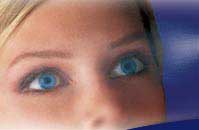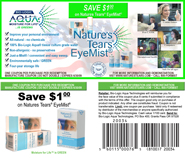
Dog Dry Eye
Be Alert for Pet Dry Eye and Be Sure Your Dog or Cat Drinks Enough Water
"Dry eye in humans is often environmentally related and has become the number one reason for United States eye doctor visits. Pets are subject to the same environmental conditions and are far more prone to eye injuries and diseases, including cat and dog dry eye. As a pet "parent," monitoring your dog or cat's eye health is critical. Eyes should always be kept moist and, of course, you must make sure your dog or cat eats properly and drinks enough water."
Sharon Kleyne, syndicated radio talk show host*
The state of eye care in pets.

According to Animal Eye Care, which runs 39 ophthalmology clinics for pets, dogs and cats are subject to numerous eye diseases. The list on their website includes blepharitis, eye injuries, cataracts, conjunctivitis, corneal ulcers, eyelid masses and glaucoma.
Sharon Kleyne, entrepreneur, water and health advocate, and host of the Sharon Kleyne Hour -Power of Water syndicated radio talk show, points out that nearly all of these eye diseases are either the result of pet dry eye (a disease characterized by insufficient water content in the protective natural tear film covering the eye), or have pet dry eye as a side effect (Pet dry eye often results from diet and/or medication).
She reiterates what many veterinarians are discovering - that treatment of these diseases will be far more effective if you simultaneously treat for cat or dog dry eye.
Cat and dog dry eye.
Sharon Kleyne's research has discovered that eye dehydration and dry eye disease among humans are more widespread than commonly reported (nearly every human suffers from occasional dry eye symptoms and it usually goes undiagnosed). "If dry eye is under-diagnosed among humans," says Mrs. Kleyne, "the condition is almost unrecognized among professional pet care experts - despite the fact that the incidence of dry eye may be even greater among dogs and cats than among humans."
"The good news," according to Mrs. Kleyne, "is that there are many ways pet owners can be proactive in monitoring their pet's eyes to keep them hydrated and healthy.
(Note: Because of the "third eyelid" membrane, a normal dog or cat eye is slightly better protected and better moisturized than a human eye. But because pets are exposed to far more high risk situations, their eyes are more subject to injuries and infections.)
Dry eye symptoms
Pet dry eye in is closely linked to conjunctivitis, red eye, blepharitis (eyelid inflammation) and corneal ulcers. Symptoms may include: (1) redness of the white part of the eye, (2) eyelid inflammation, (3) frequent eye infections and dripping, (4) lack of "shine" in the eyes or a noticeable thickening or unevenness of the tear film's usually invisible lipid (oil) component, (5) indications of eye discomfort such as frequent squinting, blinking or pawing at the eyes, (6) unusual dryness of the fur and/or mouth.
Environmental risk factors include; (1) living in an extremely dry or desert climate, (2) frequent exposure to wind, cold and solar radiation, (3) frequent exposure to dirt (very common among dogs), dust, smoke or chemical fumes, (4) prolonged exposure to climate controlled indoor environments such as forced-air heating and cooling and insulated walls and windows.
High risk dog breeds: bulldogs, cocker spaniels, lhasa apsos and west highland white terriers.
Suggestions for pet eye care, including cat and dog dry eye.
- Control exposure to high risk situations.
- Inspect your pet's eyes frequently, watching for symptoms described above and for symptoms of other eye diseases.
- See your veterinarian if your pet shown any symptoms of any eye disease, including dry eye.
- For mostly indoor pets, make sure their home is well-humidified. Open windows, have lots of plants around, set out bowls of water or purchase a room humidifier.
- Make sure your pet is well nourished and drinks enough water every day.
- Apply Nature's Tears EyeMist several times a day to maintain natural tear film water content and also to keep fur well hydrated. This routine can prevent or alleviate dry eye and help reduce dry eye as a side effect of other diseases.
Suggestions for pet watering.
Pets vary in the amount of water they like to drink and getting them to drink more can be a challenge. Do not assume that they will drink the exact right amount of water "by instinct."
- Pets should drink one cup of water per day for every 10 pounds of weight.
- Follow the recommended diet for your pet's species, age, weight, state of health and lifestyle.
- Water sitting in a bowl all day can become contaminated and also lose oxygen and therefore taste.
- Change water bowl frequently or purchase a pet watering device.
- Don't let pets drink from puddles or lakes.
- Add water to your pet's food.
- Offer them water occasionally - especially after activity.
- Pets require more water if they are ill.
*Don't miss the Sharon Kleyne Hour - Power of Water Mondays at 10 a.m. PST/PDT. The syndicated show may be heard on Voice America/World Talk Radio, Green Talk Radio and Apple iTunes. Go to www.SharonKleyneHour.com for summaries and replays of past shows.
Online Sources:
WebMD for pets, PetMD, Animal Eye Care, Free Drinking Water, eHow, Hugs Pet Products..
© 2011 Bio-Logic Aqua Research All Rights Reserved









